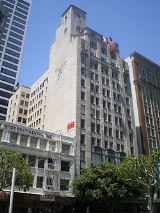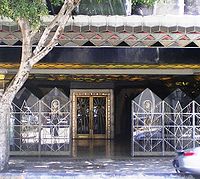
James Oviatt Building
Encyclopedia
The James Oviatt Building, commonly referred to as The Oviatt Building, is an Art Deco
highrise in Downtown Los Angeles
located at 617 S. Olive Street, half a block south of 6th St. and Pershing Square. In 1983, the Oviatt Building was listed in the National Register of Historic Places
. It is also designated as a Los Angeles Historic-Cultural Monument.
 The building is named after James Zera Oviatt (born in Farmington, Utah in 1888) who, in 1907, came from Salt Lake City to Los Angeles to work as a window dresser
The building is named after James Zera Oviatt (born in Farmington, Utah in 1888) who, in 1907, came from Salt Lake City to Los Angeles to work as a window dresser
at C.C. Desmond's Department Store. In 1912, Mr. Oviatt and a colleague, hat salesman Frank Baird Alexander, launched their partnership in men’s clothing as the Alexander & Oviatt haberdashery, at 209 West Fourth Street in downtown Los Angeles. During annual summer buying trips to Europe, James Oviatt found stylish clothing to bring back to his prospering Los Angeles store. With the emergence of French Art Deco
in the 1920s, Mr. Oviatt found the architectural style that would embody the interior design of his 1928 James Oviatt Building and its penthouse.
The Oviatt Building was designed by the Los Angeles architectural firm of Walker & Eisen
. Excavation for the Oviatt Building's construction was begun in August 1927; the building was completed in May 1928. Its furnishings included a 12-ton illuminated glass ceiling and awning by architect Ferdinand Chanut and glassmaker Gaetan Jeannin. Rene Lalique designed and created the molded glass elevator door panels, front and side doors, chandeliers, and a large panel clock. Many tons of 'Napoleon' marble and a massive, three-faced tower clock with chimes were imported from France.
Today, Cicada Restaurant is located in the huge, ornate Art Deco space on the building's ground floor and upstairs mezzanine. On most Sunday nights, the restaurant converts into a 1920s-'30s style nightclub, Maxwell DeMille's Cicada Club, complete with live bands/orchestras, singers, and dance floor.
A feature-length documentary on the Oviatt Building's history was filmed in 2008.
Art Deco
Art deco , or deco, is an eclectic artistic and design style that began in Paris in the 1920s and flourished internationally throughout the 1930s, into the World War II era. The style influenced all areas of design, including architecture and interior design, industrial design, fashion and...
highrise in Downtown Los Angeles
Downtown Los Angeles
Downtown Los Angeles is the central business district of Los Angeles, California, United States, located close to the geographic center of the metropolitan area...
located at 617 S. Olive Street, half a block south of 6th St. and Pershing Square. In 1983, the Oviatt Building was listed in the National Register of Historic Places
National Register of Historic Places
The National Register of Historic Places is the United States government's official list of districts, sites, buildings, structures, and objects deemed worthy of preservation...
. It is also designated as a Los Angeles Historic-Cultural Monument.

Window dresser
Window dressers arrange displays of goods in shop windows or within a shop itself. They may work for design companies contracted to work for clients or for department stores, independent retailers, airport or hotel shops....
at C.C. Desmond's Department Store. In 1912, Mr. Oviatt and a colleague, hat salesman Frank Baird Alexander, launched their partnership in men’s clothing as the Alexander & Oviatt haberdashery, at 209 West Fourth Street in downtown Los Angeles. During annual summer buying trips to Europe, James Oviatt found stylish clothing to bring back to his prospering Los Angeles store. With the emergence of French Art Deco
Art Deco
Art deco , or deco, is an eclectic artistic and design style that began in Paris in the 1920s and flourished internationally throughout the 1930s, into the World War II era. The style influenced all areas of design, including architecture and interior design, industrial design, fashion and...
in the 1920s, Mr. Oviatt found the architectural style that would embody the interior design of his 1928 James Oviatt Building and its penthouse.
The Oviatt Building was designed by the Los Angeles architectural firm of Walker & Eisen
Walker & Eisen
Walker & Eisen was an architectural partnership of architects Albert R. Walker and Percy A. Eisen in Los Angeles, California. Some of their notable buildings include the Fine Arts Building, James Oviatt Building, The Hotel Normandie , The Platt Building and the Beverly Wilshire Hotel. They are...
. Excavation for the Oviatt Building's construction was begun in August 1927; the building was completed in May 1928. Its furnishings included a 12-ton illuminated glass ceiling and awning by architect Ferdinand Chanut and glassmaker Gaetan Jeannin. Rene Lalique designed and created the molded glass elevator door panels, front and side doors, chandeliers, and a large panel clock. Many tons of 'Napoleon' marble and a massive, three-faced tower clock with chimes were imported from France.
Today, Cicada Restaurant is located in the huge, ornate Art Deco space on the building's ground floor and upstairs mezzanine. On most Sunday nights, the restaurant converts into a 1920s-'30s style nightclub, Maxwell DeMille's Cicada Club, complete with live bands/orchestras, singers, and dance floor.
A feature-length documentary on the Oviatt Building's history was filmed in 2008.
See also
- List of Registered Historic Places in Los Angeles
- List of Los Angeles Historic-Cultural Monuments in Downtown Los Angeles

